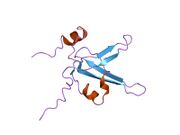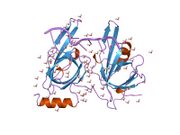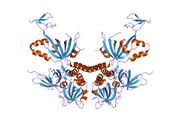Biology:Replication protein A1
From HandWiki
 Generic protein structure example |
Replication protein A 70 kDa DNA-binding subunit is a protein that in humans is encoded by the RPA1 gene.[1]
Interactions
Replication protein A1 has been shown to interact with:
- BRCA2,[2]
- BLM,[3][4][5]
- MCM2,[6]
- MCM4,[6]
- MCM6,[6]
- MCM7,[6]
- MUTYH,[7]
- ORC2L,[6]
- ORC6L,[6]
- P53,[8][9]
- RPA2,[10][11]
- RPA3,[11][12]
- TIPIN,[13]
- TP53BP1,[14] and
- XPA.[15]
See also
- Replication protein A
- Replication protein A2
- Replication protein A3
- Single-stranded binding protein
References
- ↑ "Cloning, overexpression, and genomic mapping of the 14-kDa subunit of human replication protein A". J Biol Chem 268 (9): 6131–8. April 1993. doi:10.1016/S0021-9258(18)53229-4. PMID 8454588.
- ↑ "Interaction between BRCA2 and replication protein A is compromised by a cancer-predisposing mutation in BRCA2". Oncogene 22 (1): 28–33. January 2003. doi:10.1038/sj.onc.1206071. PMID 12527904.
- ↑ "Replication protein A physically interacts with the Bloom's syndrome protein and stimulates its helicase activity". J. Biol. Chem. 275 (31): 23500–8. August 2000. doi:10.1074/jbc.M001557200. PMID 10825162.
- ↑ "Telomere-binding protein TRF2 binds to and stimulates the Werner and Bloom syndrome helicases". J. Biol. Chem. 277 (43): 41110–9. October 2002. doi:10.1074/jbc.M205396200. PMID 12181313.
- ↑ "The time course and chromosomal localization of recombination-related proteins at meiosis in the mouse are compatible with models that can resolve the early DNA-DNA interactions without reciprocal recombination". J. Cell Sci. 115 (Pt 8): 1611–22. April 2002. doi:10.1242/jcs.115.8.1611. PMID 11950880.
- ↑ 6.0 6.1 6.2 6.3 6.4 6.5 "Interaction and assembly of murine pre-replicative complex proteins in yeast and mouse cells". J. Mol. Biol. 327 (1): 111–28. March 2003. doi:10.1016/s0022-2836(03)00079-2. PMID 12614612.
- ↑ "Human homolog of the MutY repair protein (hMYH) physically interacts with proteins involved in long patch DNA base excision repair". J. Biol. Chem. 276 (8): 5547–55. February 2001. doi:10.1074/jbc.M008463200. PMID 11092888.
- ↑ "The interaction of p53 with replication protein A mediates suppression of homologous recombination". Oncogene 23 (56): 9025–33. Dec 2004. doi:10.1038/sj.onc.1207982. PMID 15489903.
- ↑ "UV-induced DNA incision and proliferating cell nuclear antigen recruitment to repair sites occur independently of p53-replication protein A interaction in p53 wild type and mutant ovarian carcinoma cells". Carcinogenesis 22 (12): 1971–8. Dec 2001. doi:10.1093/carcin/22.12.1971. PMID 11751427.
- ↑ "Replication-mediated DNA damage by camptothecin induces phosphorylation of RPA by DNA-dependent protein kinase and dissociates RPA:DNA-PK complexes". EMBO J. 18 (5): 1397–406. March 1999. doi:10.1093/emboj/18.5.1397. PMID 10064605.
- ↑ 11.0 11.1 "Structure of the RPA trimerization core and its role in the multistep DNA-binding mechanism of RPA". EMBO J. 21 (7): 1855–63. April 2002. doi:10.1093/emboj/21.7.1855. PMID 11927569.
- ↑ "The RPA32 subunit of human replication protein A contains a single-stranded DNA-binding domain". J. Biol. Chem. 273 (7): 3932–6. February 1998. doi:10.1074/jbc.273.7.3932. PMID 9461578.
- ↑ "The human Tim/Tipin complex coordinates an Intra-S checkpoint response to UV that slows replication fork displacement". Mol. Cell. Biol. 27 (8): 3131–42. April 2007. doi:10.1128/MCB.02190-06. PMID 17296725.
- ↑ "53BP1 is associated with replication protein A and is required for RPA2 hyperphosphorylation following DNA damage". Oncogene 24 (35): 5423–30. August 2005. doi:10.1038/sj.onc.1208710. PMID 15856006.
- ↑ "An interaction between the DNA repair factor XPA and replication protein A appears essential for nucleotide excision repair". Mol. Cell. Biol. 15 (10): 5396–402. October 1995. doi:10.1128/mcb.15.10.5396. PMID 7565690.
Further reading
- "Replication protein A (RPA): the eukaryotic SSB.". Crit. Rev. Biochem. Mol. Biol. 34 (3): 141–80. 1999. doi:10.1080/10409239991209255. PMID 10473346.
- "Replication protein A phosphorylation and the cellular response to DNA damage.". DNA Repair (Amst.) 3 (8–9): 1015–24. 2005. doi:10.1016/j.dnarep.2004.03.028. PMID 15279788.
- "Interaction of DNA polymerase alpha-primase with cellular replication protein A and SV40 T antigen.". EMBO J. 11 (2): 769–76. 1992. doi:10.1002/j.1460-2075.1992.tb05110.x. PMID 1311258.
- "Characterization of a cDNA encoding the 70-kDa single-stranded DNA-binding subunit of human replication protein A and the role of the protein in DNA replication.". J. Biol. Chem. 266 (18): 12090–8. 1991. doi:10.1016/S0021-9258(18)99069-1. PMID 2050703.
- "An interaction between the DNA repair factor XPA and replication protein A appears essential for nucleotide excision repair.". Mol. Cell. Biol. 15 (10): 5396–402. 1995. doi:10.1128/mcb.15.10.5396. PMID 7565690.
- "Rpa4, a homolog of the 34-kilodalton subunit of the replication protein A complex.". Mol. Cell. Biol. 15 (6): 3119–28. 1995. doi:10.1128/mcb.15.6.3119. PMID 7760808.
- "High-resolution genomic mapping of the three human replication protein A genes (RPA1, RPA2, and RPA3).". Genomics 20 (2): 249–57. 1994. doi:10.1006/geno.1994.1161. PMID 8020972.
- "Functional domains of the 70-kilodalton subunit of human replication protein A.". Biochemistry 35 (32): 10558–68. 1996. doi:10.1021/bi9607517. PMID 8756712.
- "Structure of the single-stranded-DNA-binding domain of replication protein A bound to DNA.". Nature 385 (6612): 176–81. 1997. doi:10.1038/385176a0. PMID 8990123. Bibcode: 1997Natur.385..176B.
- "HIV-1 nucleocapsid protein and replication protein A influence the strand displacement DNA synthesis of lentiviral reverse transcriptase.". AIDS 11 (4): 534–6. 1997. PMID 9084803.
- "The human immunodeficiency virus transactivator Tat interacts with the RNA polymerase II holoenzyme.". Mol. Cell. Biol. 17 (4): 1817–23. 1997. doi:10.1128/MCB.17.4.1817. PMID 9121429.
- "Identification of DNA replication and cell cycle proteins that interact with PCNA.". Nucleic Acids Res. 25 (24): 5041–6. 1998. doi:10.1093/nar/25.24.5041. PMID 9396813.
- "The RPA32 subunit of human replication protein A contains a single-stranded DNA-binding domain.". J. Biol. Chem. 273 (7): 3932–6. 1998. doi:10.1074/jbc.273.7.3932. PMID 9461578.
- "Interaction of human rad51 recombination protein with single-stranded DNA binding protein, RPA.". Nucleic Acids Res. 26 (23): 5388–93. 1999. doi:10.1093/nar/26.23.5388. PMID 9826763.
- "Replication-mediated DNA damage by camptothecin induces phosphorylation of RPA by DNA-dependent protein kinase and dissociates RPA:DNA-PK complexes.". EMBO J. 18 (5): 1397–406. 1999. doi:10.1093/emboj/18.5.1397. PMID 10064605.
- "Functional and physical interaction between WRN helicase and human replication protein A.". J. Biol. Chem. 274 (26): 18341–50. 1999. doi:10.1074/jbc.274.26.18341. PMID 10373438.
- "Substrate specificities and identification of putative substrates of ATM kinase family members.". J. Biol. Chem. 274 (53): 37538–43. 2000. doi:10.1074/jbc.274.53.37538. PMID 10608806.
- "Replication protein A physically interacts with the Bloom's syndrome protein and stimulates its helicase activity.". J. Biol. Chem. 275 (31): 23500–8. 2000. doi:10.1074/jbc.M001557200. PMID 10825162.







